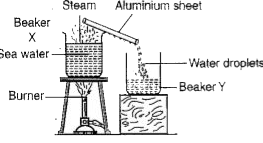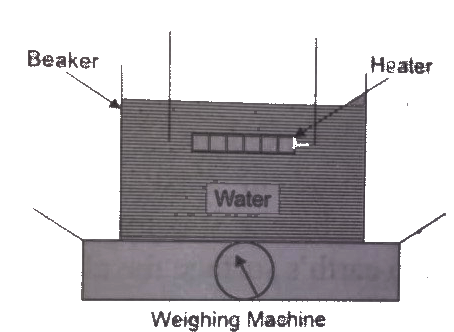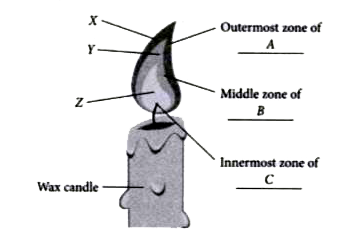Abida and Ramesh were doing an experiment in which water was to be heated in a beaker. Abida kept the beaker near the wick in the yellow part of the candle flame. Ramesh kept the beaker in the outermost part of the flame. Whose water will get heated in a shorter time?
The correct Answer is:Ramesh's beaker will get heated in a shorter time as the outermost part of the flame is the hottest whereas the part near the wick in the yellow part of the candle flame, where Abida kept the beaker is the least hot.
Similar Questions
Jyoti and Sanjay were doing an experiment in which water was to be heated in a beaker. Jyoti kept the beaker near the wick in the yellow part of the candle flame. Sanjay kept the beaker in the outermost part of the flame. Which water will get heated in a shorter time?
View SolutionAbida and Ramesh want to heat water taken in separate beakers . Abida kept the beaker near the wick in the yellow part of the candle flame. Ramesh kept the beaker in the outermost part of the flame . Whose water will get heated in a shorter time ? Why ?
View Solution
Knowledge Check
In the given experiment, some sea water was heated in a beaker. After some time, it was observed that the number of water droplets formed on the aluminium sheet become less and less. Why was this so?

(i) The aluminium sheet had become hotter
(ii) The rate of condensation had decreased
(iii) Beaker X had become hotterA(i) and (iii) onlyB(i) and (ii) onlyC(ii) and (iii) onlyD(i),(ii) and (iii)As part of an experiment to determine the latent heat of vaporisation of water, a student boils some water in a beaker using an electric heater as shown below. The student notes two sources of error.

Error-1: thermal energy is lost from the sides of the beaker
Error -2: As the water is boling water splashes out of the beaker
Which of the following gives the correct effect of these two errors on the calculated value for the specific lalent heat?AError-1 = increases , Error-2 = DecreaseBError-1 = increases , Error-2 = increaseCError-1 = Decreases , Error-2 = increaseDError-1 = Decreases , Error-2 = DecreaseA student takes some water in a beaker and heats it over a flame for determining its boiling point. He keeps on taking its temperature reading. He would observe that the temperature of water :
Akeeps on increasing regularlyBkeeps on increasing ireegularlyCfirst increases slowly, then decreases rapidly and eventually becomes constantDfirst increases gradually and then becomes constant
The water heated by Ramesh will get heated in a shorter time because he kept his beaker near the hottest zone of the flame. Comment.
View SolutionName the process by which
water in a beaker gets heated by the burner kept below it.
View SolutionAll the students of class 9 were performing experiments to study the types of solutions in the science laboratory. Vikalp took some water in a beaker and heated it slowly with the help of a burner.He starded adding postassium nitrate to the hot water with a spoon and stirred it with a glass rod continuously, so that potassium nitrate goes on dissolving in water. Vikalp took the temperature of water up to 40∘C, and then keeping the temperature constant, went on adding more and more of potassium nitrate to water, till no more potassium nitrate dissolved in it and some potassium nitrate is also left undissolved at the bottom of beaker. The contents of the beaker are now filtered through a filter paper arranged in a funnel. A clear solution is obtained in the form of a filtrate
(a) Depending upon the amount of solute present, the solution can be classified into two groups. Name these two groups of solution
(b) What type of potassium nitrate solution prepared by Vikalp at 40∘C ? Define the type of solution prepared by Vikalp
(c) What will happen if the potassium nitrate solution prepaerd by Vikalp at 40∘C ? is heated further (say to 60∘C) ? Give reason for your answer
(d) What will happen if the potassium nitrate solution prepared by Vikalp at 40∘C is allowed to cool (say to 20∘C) ? Give reason for your answer
(e) Which term/phrase can be used to convey that a maximum of 106 grams of potassium nitrate can be dissolved in 100 grams of water at a temperature of 60∘C ?
(f) What values are displayed by Vikalp in this episode ?
View SolutionA student heats a beaker containing ice and water. He measures the temperature of the content of the beaker as a function of lime. Which of the following would correctly represent the result ? Justify your choice .

View SolutionA flame is the visible gaseous part of a fire. It is a zone of combustion of gaseous substances accompanied by evolution of heat and light. All substances do not burn with a flame. Only those substances that vaporise during burning produce flame. A candle flame is taken to study the various zones of a flame.

Different zones of a candle flame are marked by the letters (A), (B) and (C).
Which of the following statements are correct?
(I) (B) is the hottest part of the flame.
(II) (C) is moderately hot.
(III) (A) is the hottest part of the flame.
(IV) (A) is moderately hot whereas (C) is the coldest part.
(V) (C) is the luminous zone.
(VI) (B) is the luminous zone.
(VII) (A) is the dark zone.
View Solution
